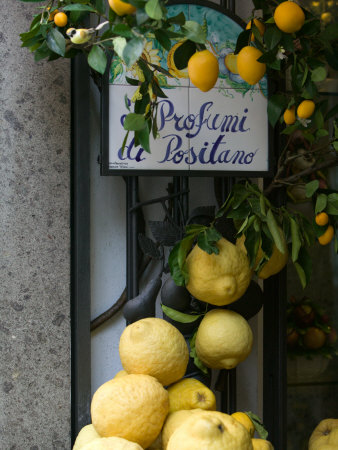|
Your
patronage of our affiliate
partners supports this web site.
We thank you! In other words, please shop at LBC
Gift Galerie!


Citron
Art Print
Scholnhammer,...
Buy at AllPosters.com

La Belle Cuisine
Julia’s Fruit Sherbets
 
The Way to Cook
by Julia Child, 1994, Alfred A. Knopf
“People
of a certain age always remember the Sunday chore of chipping the big block
of ice to make pieces of freezer-fitting size, and of hand cranking for what
seemed like hours until at last it would crank no more. How easy it is now
to
make ice creams and sherbets, and we have such a choice of machines, from
the luxurious self-contained models to the simple small hand-crankers that
you stick in the
freezer itself.
I shall not go into the mechanics of freezing, but shall concentrate on a
handful
of formulae that I have found successful. Although you can freeze
almost any-
thing containing the right proportions, just because it has frozen
well does not
mean it will be a delight to eat. Fresh pineapple, for
instance – what a great per-
fume when
it is fully ripe; freeze it as is,
however, and the perfume has almost
disappeared. Freeze a Crenshaw melon and
you have nothing at all, but freeze
a strawberry
purée and you have the
essence of the fruit. In other words, success
depends on
the fruit itself
and its intensity of flavor, and I hope the following
will give you
ideas to
experiment with on your own."
Terminology
Note:
Sorbet vs. sherbet. I know there is sometimes a distinction made that the
one contains milk and the other does not, or vice versa. As far as I am
concerned they
are one and the same, except that sorbet is contemporary
cuisine chic-speak.
Master Recipe
Fresh Lemon Sherbet
“It’s
lemon sherbet in party dress when you serve it in balloon-shaped goblets,
top it with a julienne of home-candied lemon peel, and pour around it a
shallow pool of aquavit. I first had this splendid combination in Venice.”
For 2 quarts,
serving 10 to 12
4 to 6 large lemons – enough to make 1/2 scant cup of zests
(yellow part of peel only) and 1 cup of juice
2 1/2 cups sugar
4 cups water
2 egg whites lightly beaten into a foam with 1/8 teaspoon salt *
1 cup or so iced aquavit (2 hours in freezer)
Candied lemon peel, optional (see Special Note)
Special equipment suggested: A vegetable peeler; an
electric blender –
more efficient for this purée than the food processor; a
2-quart saucepan
with tight-fitting cover; an ice cream scoop; a mixing bowl
with a tray of
ice cubes and water to cover them, for a quick chill; chilled
goblets
The sherbet. Remove the zests from the lemons with the
vegetable peeler.
To extract their flavor, pulverize them 2 minutes with 1
cup of sugar in the electric blender; add 1 1/2 cups of the water and
pulverize 2 minutes more. Pour into the saucepan, add the rest of the sugar,
bring to the simmer, and swirl the pan by its handle for several seconds,
until you are sure the sugar has completely dissolved. Remove from heat.
Pour in the cup of lemon
juice and the rest of the water; stir for several
minutes over the ice cubes
and water until well chilled. Whisk in the egg
whites, and freeze according
to your machine directions.
Serving. The moment of serving, scoop a ball or two of
sherbet into each chilled goblet, pour around it a big spoonful of iced
aquavit, and, if you
wish, fork out a half dozen strands of the candied peel
for decoration.
* Be sure that your eggs come
from a certified and carefully inspected source –
and make every effort to
see that poultry inspection and sanitary regulations
are strictly enforced
in your area. If we, the public, are alert and demanding,
our elected
officials have no choice but to follow.
Use Grade AA or Grade A eggs, and never buy or use cracked or dirty eggs
since broken or contaminated shells may have allowed harmful bacteria to
penetrate.
Keep raw eggs and egg dishes refrigerated, serve cooked egg
dishes as soon as
they are done; wash hands, utensils, and work surfaces in
hot soapy water
whenever raw eggs are involved in a recipe.
Eggs – about 1 in every 10,000 at this writing [1994] - may contain
salmonella bacteria. The bacteria multiplies at room temperature, but it is
quiescent when chilled. It is killed when the egg is heated over 140 degrees
F, or is hard boiled,
and it is also killed by a fairly strong dose of acid
– lemon juice or vinegar.
Fresh Orange Sherbet
Follow the general directions for lemon sherbet, using 5 or 6
large fine
navel oranges. After cutting off the zest, squeeze the juice –
you’ll want
a quart [4 cups] of juice rather than water. Purée half the
zests with the
sugar, as described, and complete the sherbet. Candy the rest
of the
zests. Serve the sherbet with a big spoonful of iced orange liqueur.
Pink Grapefruit Sherbet
Follow the general directions for the lemon sherbet, using 3
or 4 large fine pink grapefruit, and make the following exceptions. Purée
half the zests for the sherbet, and reserve the rest for candying. Then cut
off all the white part of the peel to expose the grapefruit flesh. Cut the
segments from the dividing membranes, and place in a quart measure, adding
to it enough juice from the remains to fill the measure – all juice and
pulp, but no water. Proceed with
the recipe. Serve the sherbet with a big
spoonful of iced kirsch.
Fresh Pineapple Sherbet in the Half Shell
“Fresh
pineapple by itself, even though beautifully ripe, loses its taste when
frozen. You need therefore to intensify it but still keep that pure
pineapple
flavor, and a judicious use of the canned fruit achieves that
desired effect.
Serve it in the pineapple shell.”
For about 1
quart, serving 4 to 6
A 10-ounce can of pineapple slices in syrup
1 cup sugar
1 very ripe fresh pineapple
3 tablespoons white rum
The grated peel and juice of 1 lemon
Special equipment suggested: A grapefruit knife or
pineapple corer;
a 6-cup saucepan with tight-fitting cover; an electric
blender or food
processor; a bowl of ice cubes and water, for rapid chilling
Candying the canned pineapple. Drain the juice from
the canned pine-
apple and bring it to the simmer in the saucepan with the
sugar, swirling the pan until the sugar has dissolved completely. Then cover
tightly and boil the
syrup to the “crack” stage (238 degrees F – when
bubbles are thick). Add 3 pineapple slices and boil again to 238 degrees F –
to candy them. Remove
the slices from the syrup and, when cool, cover and
chill them.
The fresh pineapple. Cut a cap off the side of the
pineapple [a thick slice – illustration in cookbook]. Using a grapefruit
knife or pineapple corer, remove the meat and hard central core from the
pineapple – except for preserving the pineapple shell intact, you don’t have
to be neat here.
The sherbet. In a blender or processor, purée the pulp
and the uncooked canned pineapple slices with the boiled-down pineapple
syrup, the rum, and the grated lemon peel and lemon juice. Stir for several
minutes over ice and water to chill, then freeze according to your machine
directions. Cover and chill the pineapple shell.
Serving. Let the sherbet soften 15 minutes or so in
the refrigerator, then
pack into the chilled shell. Decorate with the
candied pineapple slices.
Ahead-of-time note: You may fill and freeze the shell,
but let the sherbet
soften
15 to 20 minutes in the refrigerator before
decorating and serving.
Special Note
Candied Lemon, Orange, or Grapefruit Peel
“Candied
citrus peel is a charming edible decoration for sherbets,
puddings,
and many
fruit desserts. Once made, refrigerate in a
covered jar, where it
will keep
for weeks.”
Enough for at
least 12 servings
The zests (colored part of peel only) of 4 large fine lemons,
3 oranges,
or 2 grapefruit
1 cup sugar
1/3 cup water
Special equipment suggested: A vegetable peeler; a
6-cup saucepan
with tight-fitting cover
Remove the zests with the vegetable peeler and cut them into
neat julienne strips 1 1/2 inches long and less than 1/8 inch wide. Simmer
in 1 quart of water 6 minutes, drain, rinse in cold water, and set aside.
Bring the sugar
and water to the simmer in the saucepan, and when the sugar
has dissolved completely, cover the pan tightly and boil and moment or two,
until the last drops of the syrup to fall from the end of a metal spoon form
a thread. Remove from heat, stir in the peel, let steep for 1 hour, and it
is ready to use.
Fresh Strawberry Sherbet with
Fresh Strawberries
“It’s
just a purée of strawberries with sugar and a touch of lemon, but
when
you
freeze it you have the marvelous essence of pure strawberry.
I don’t know
a
better formula for strawberry sherbet.”
For 1 quart,
serving 6 to 8
For the sherbet
1 1/2 quarts fine fresh ripe strawberries
2 cups sugar
3 tablespoons freshly squeezed lemon juice
For decoration
1 quart or so fine fresh ripe strawberries
2 tablespoons freshly squeeze lemon juice
1 teaspoon red wine vinegar
1/4 cup or more sugar
Special equipment suggested: A food processor; a bowl
of ice cubes
and water for quick chilling
The sherbet mixture. Stem the strawberries, drop them
into a large bowl
of cold water, swish gently, and drain immediately. Purée
them in the processor with the sugar and lemon juice, continuing until the
sugar has dissolved completely – taste analytically to be sure. Stir over
the ice and
water to chill thoroughly; freeze according to your machine
directions.
The strawberry garnish. An hour or so before serving,
wash and stem the second group of strawberries and drain thoroughly on a
rack; quarter or
halve them lengthwise. Toss gently in a bowl with the lemon
juice, wine
vinegar, and sugar to taste. Cover and chill.
Serving. Spoon the sliced strawberries around each portion of sherbet;
almond wafers [Tuiles aux Amandes] make
an attractive accompaniment.
Fresh Raspberry Sherbet
Substitute fresh raspberries for strawberries, but strain the
puree to
eliminate seeds before freezing the sherbet.
Featured Archive Recipes:
Simply Sorbet:
(10 sorbet recipes from
"Charlie Trotter's Desserts")
Mouthwatering Melons
Peach Ice Cream, The Best!
We all scream for ice cream!
Index - Fruit Recipe Archives
Index - Miscellaneous Dessert Recipes
Summer Holiday Recipe Index
Daily Recipe Index
Recipe Archives Index
Recipe Search
|










